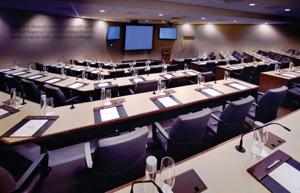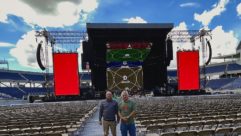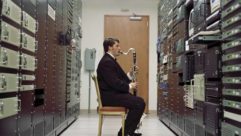

Friends in Low Places
The Hyatt Regency Crystal City in Arlington, Va., has a lot going for it. It’s minutes from Washington, D.C., and the Pentagon, and even closer to Reagan National Airport. But a recent renovation provided the perfect opportunity to add an amenity that would give the hotel a competitive edge: a complete, distance conferencing-enabled meeting room.
SHAPING UPAUDIO ACHES, SUBWOOFER WOESIN CONTROLLESSONS LEARNED
A baseball diamond shape and low ceiling in the Hyatt Regency Crystal City’s teleconference theater made for audio integration challenges.
Credit: Huber
CHALLENGE: Install a distance conferencing system in a tiered, diamond-shaped, basement-level hotel conference room.
SOLUTION: Use custom-mounted in-ceiling subwoofers, wide-dispersion loudspeakers, and echo-acoustic cancellation for crisp audio, plus incorporate a three-point video design for easy visibility.
THE HYATT REGENCY CRYSTAL CITY IN Arlington, Va., has a lot going for it. It’s minutes from Washington, D.C., and the Pentagon, and even closer to Reagan National Airport. But a recent renovation provided the perfect opportunity to add an amenity that would give the hotel a competitive edge: a complete, distance conferencing-enabled meeting room.
Planning began as early as 2005 to upgrade a conference room in the hotel’s lower level. “It didn’t have any audiovisual; it was just a bare room with very basic stuff,” says Jean-Marc Dizard, general manager at the Hyatt Regency Crystal City. “We initially thought to level the room and make it another conference room—no frills. But when we had the discussions, we talked about making it a high-tech room.”
The hotel’s regular AV provider brought in AV/Com Integrators of Severn, Md., to design and install the room’s new systems. “We were looking to bring it up to something that would be different and not widely available throughout the Washington market,” says Deidra McMillin, director of sales and marketing at the Hyatt Regency Crystal City. In March 2006, with distance conferencing and computer connectivity as priorities, John Bangs, president of AV/Com Integrators, and his company began the six-week-long process of turning a typical conference room into a state-of-the-art teleconference theater.
Inside, a center aisle, flanked by 10 long tables and 90 seats, leads down five tiers that fan out from the front of the room. The AV closet is located behind the top row of seats. The room is fairly secluded from the rest of the hotel, so sound-bleeding wouldn’t be an issue. But designing an AV system that allows 90 people to participate in a teleconference and easily view displays from all angles, would be.
To that end, Bangs installed an 87-inch-by-116-inch Da-Lite Cosmopolitan Electrol screen and a Mitsubishi XL5900U 4000 lumens projector front and center, because “you want the smallest print to be the biggest,” he says. He admits that a windowless room normally wouldn’t require a projector with 4000 lumens, but the screen’s proximity to a pair of LCDs would make lower brightness very noticeable.
On either side of the screen is a 65-inch Sharp LC65D90U Aquos HD LCD monitor for Polycom videoconferencing, angled toward opposite ends of the room. The LCDs’ unique positioning is due to the room’s shape, which Bangs compares to a baseball diamond, with the projection screen as home plate: “You have to have one [display] on the third base line for the first-base people and one [display] on the first base for the third-base people.”
While a diamond shape is normally great for acoustics, the subterranean room’s low ceiling was less ideal for dispersion. There wasn’t enough height for a typical three-speaker design, so Bangs and his engineer spent a couple days on their computers searching the Internet for loudspeakers with a smooth, wide dispersion, and plugged each possibility into their Ease simulation software from Berlin-based Acoustic Design Ahnert.
“You basically create a CAD-like model of the room and Ease allows you to test that room acoustically,” says Bangs. They settled on Martin Audio’s Wavefront Theatre WTUB compact loudspeakers, which have a dispersion of 40 degrees vertical and 120 degrees horizontal, and hung them from the ceiling. The size of the Martin Audio speakers was also an important factor; any bigger and Bangs would have had to lower the projection screen, making visibility difficult from the back row of seats.
For teleconferencing, Bangs needed to find a way for up to 90 people to speak without creating painful acoustic feedback from the open transducers. To do this, he installed 45 Audio-Technica U857QL quick-release gooseneck mics—one for every two seats—plus one more for the presenter’s podium, and used Biamp’s AEC2w two-channel acoustic echo canceling card to reduce unwanted noise.
Web Extra: Full Equipment List
AV/Com Integrators installed the following equipment at the Hyatt Crystal City in Arlington, Va.
- 2 AMX NXD-CV7 7-inch Modero wall-mount touch-screen panels
- 2 AMX NI3100 controllers
- 1 AMX PSN6.5 power supply
- 1 Audio Technica AEW-5111D dual body pack wireless transmitter
- 1 Audio Technica AT892c-TH head-worn microphone in beige
- 2 Audio Technica AT899cW lavaliere microphone with attachment kit
- 46 Audio Technica U857QL quick-release gooseneck microphones
- 45 Audio Technica AT8646QM shock-mounts for gooseneck microphones
- 3 Biamp Audia FLEX CM Audia CobraNet DSPs
- 6 Biamp IP2 two-channel input cards
- 5 Biamp OP2e two-channel output cards
- 24 Biamp AEC2w two-channel acoustic echo canceling cards
- 1 Biamp TI-2 two-channel telephone interface card
- 1 Da-Lite 87×116-inch Cosmopolitan Electrol with ceiling trim kit and LVC
- 1 Extron 60-220-15 Crosspoint 300 128HV matrix switch
- 12 Extron 26-531-01 6-inch VGA male to BNC female cables
- 6 Extron 60-589-11 CPM 200-1 Mini Architectural Adapter Plate (MAAP) table-top bays
- 6 Extron 70-293-13 stereo mini Phoenixes
- 6 Extron 70-315-11 single blank Architectural Adapting Plates (AAP)
- 6 Extron 70-309-11 VGA MAAPs
- 1 Extron WPB107 presenter’s jack
- 1 Extron WPB103 presenter’s jack
- 1 Extron 60-736-01 DVS 304 scaler
- 1 LabGruppen C16:4 four-channel amplifier
- 1 Listen Technologies LS-03-072 assisted listening performance FM system
- 2 Martin Audio WTUB loudspeakers
- 1 Middle Atlantic WRK 44SA-32 77-inch rack
- 1 Middle Atlantic WRK-RR16 rear rack rail
- 1 Middle Atlantic EWR 16-22 16-unit rack
- 1 Middle Atlantic PDT-2X1020 20-outlet, 20-amp power strip double
- 4 Middle Atlantic HS 100-count square drive screws
- 1 Mitsubishi XL5900U 4000-lumen projector
- 1 Polycom VS8000 with power cam
- 2 Sharp LC56D90U HD LCD monitors
- 1 Smart Technologies ID 350 Sympodium
- 1 Sony CAMWMBKT video camera wall-mount bracket
- 6 Tannoy CMS110 TB ceiling-mounted subwoofers
- 1 Tannoy 80013623 i6AW ICT white AV room monitor
- 1 Tascam CD-160 CD player
- 1 Tascam DVRA1000HD hard drive DVR recorder
— Source: AV/Com Integrators
“Without it, you would have nothing but pure feedback,” Bangs says. Wireless mics are available for presentations, but aren’t necessary for teleconferencing. “The Biamp echo acoustic canceling is so phenomenal that we’re able to have the microphones up loud enough that you can walk anywhere you want in the room and people on the other end don’t know you’re moving,” he adds. “They don’t have a clue that you’re moving and changing from one microphone to another.”
The subwoofers were originally set to mount in a small presenter’s stage at the front of the room, however two days before installation was to begin, the stage was demolished—without Bangs’ knowledge.
With the loss of the presenter stage for the subwoofers, Bangs decided to mount them in the walls—only to find out that they were fire walls that required special fire enclosures around each sub-woofer. Specifying these fire enclosures would add six to eight weeks onto the project, but with only four weeks left until the deadline, Bangs was forced to find yet another solution.
Next he turned his attention to the ceiling. “We created a bank of six Tannoy [CMS110 TB] ceiling-mounted speakers, but we engineered it when we weren’t actually in the room,” Bangs explains. “When we came back [to the hotel] and they took out the ceiling, there was the biggest concrete beam I’ve ever seen in my life.”
The structural beam measured 4 feet wide by 6 feet high, ran the length of the building, and was only 1 inch above the ceiling drop tile in some places. The spot where Bangs planned to mount the Tannoys was just behind the beam, but their mounting grid was too big to fit. Bangs explained the situation to Tannoy, and the company agreeably remounted the sub-woofers to the back of a 2×2 grid. Within two days, they were installed in front of the WTUBs.
“It was actually good that the stage was removed,” admits Bangs. “By putting six of them [in a row], they all just kind of grew together, and there’s just a really strong bass presence in that room.”
All the AV is AMX-controlled, with one NXD-CV7 7-inch Modero wall-mount touch-screen panel at the front of the room and one in the AV closet. The room has eight laptop jacks: in the podium, in the AV closet, and at the aisle ends of the first, third, and fifth rows. Once connected, presenters can choose to display materials on either the screen or the monitors. “You can compare two proposals or two presentations side-by-side with the people in the audience, so there’s tremendous flexibility,” says Bangs.
Presenters can also connect to the Smart ID 350 Sympodium, which, according to Bangs, “takes your laptop and puts it on steroids” by turning it into a touch screen. The accompanying Magic Pen allows a user to write directly on a presentation via the screen, save the document with the written changes, and e-mail it to the audience.
Another unique feature is the Tascan DVR 1000, which allows users to record an entire day’s meeting and save it to a DVD. “A lot [of other hotels] use a hard drive DVR, but many of them require you to hit play after about four to six hours,” says Bangs. “[The Tascan DVR 1000] allows you to record 13 hours of uninterrupted audio.”
The Middle Atlantic rack unit in the teleconference theater’s AV closet houses AMX integrated controllers and Biamp Audio Flex CMs.
The Hyatt Regency Crystal City was one of AV/Com Integrators’ first hotel projects, but many followed after. The remodeling challenges, especially, helped prepare the company for future unscripted situations.
“The thing everyone has to understand is if you’re going to work with a hotel, the number one thing is you have to be flexible. If you’re not flexible, you cannot work in the hospitality industry,” Bangs insists. “Hotels cannot afford to have down time.” In fact, Bangs is bringing on more staff to increase reliability for his clients.
Since its completion in spring 2006, the teleconference theater has received rave reviews. “The people who have used it love it,” says McMillin. “The people have specifically booked this hotel because of that space. It’s great for training, a teleconference, or a videoconference. It’s a perfect room.” She credits the Smart Sympodium and the AMX control, but also the teleconferencing system. “The audio is just superb. You can have a bunch of people in the room talking at the same time, and if you’re on the other end of the phone you can hear everybody individually.”
For Dizard, the $180,000 price tag was worth every penny. “I’m very pleased with the sound of it and with the quality of the equipment in there,” he says. “It’s really working well.”










